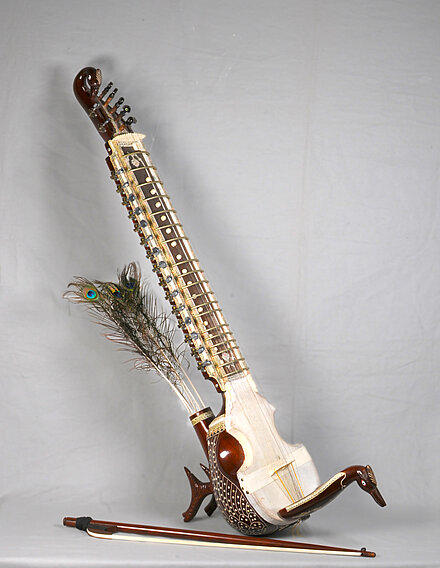Taus (Mayuri vina) – De 536

Taus (Mayuri vina, Bālasarasvati)
Gestrichene Langhalslaute in Pfauenform, Nordindien (Punjab). Das Instrument, das von Sikh-Musikern gespielt wird, gehört zur Gruppe der Vinas. Nach dem 11. Jh. entwickelten sich zentralasiatische Langhalslauten in Indien zu eigenständigen Typen (Tambūrā, Sitār, Sarasvatī vīṇā, Rudra vīṇā).
Mayura (Sanskrit) und Taus (Farsi/Urdu) bedeuten Pfau. Sanskrit bāla heißt "jugendlich", der Pfau ist der Reittier der Sarasvati, der in südindischen Göttin der Musik und der Weisheit. Die Mayuri vina ist eine größere Variante der Dilruba und der Esraj, die zur selben Instrumentenfamilie gehören, ihr Ambitus ist tiefer. Der am Boden sitzende Spieler hält das vorne auf dem Boden aufsitzende Instrument mit seiner linken Schulter.
Der Taus-Spieler Bhai Avtar Singh (1925–2006) berichtet in einem Interview von 2003 die Erfindungslegende des Instruments, die ihm als jungem Schüler erzählt worden war: “The Guru and his Sikhs were singing outdoors under a tree enjoying God and nature. As was the old tradition, they were playing some string instruments. After a while, the musicians took a rest, and they leaned their instruments up against a tree. A peacock waddled into the group and cried in the wailing sound that belongs only to the peacock. All the instruments resonated with the peacock cry, and the strings started humming. Guru Sahib liked that ethereal sound so much that he said: “Let us make an instrument that sounds like this—a combination of the resonation of all the string instruments and the plaintive cry of the peacock.” And that's how the taus was invented under the supervision of Guru Har Gobind.” (Cassio/Nirinjan 2019, 285-6).
Gesamtlänge 118 cm.
Teile: Korpus mit Hals, Bogen, in Korpusrückseite einsteckbare Pfauenfedern, auf untere Frontseite aufsteckbarer Pfauenkopf, zwei auf Rückseite aufschraubbare Pfauenfüße (4 Schrauben).
4 Spielsaiten, 5 Nebensaiten, 15 Resonanzsaiten. Der Korpus ist fellbespannt. Der mit Pferdehaar bespannte Bogen wird mit einer Schnur in Spannung gehalten.
Das Instrument wurde im September 2023 in der Ausstellung Musical & Instruments (ISGMA Würzburg) gezeigt.
Provenienz: Stiftung Fritz Degel (Blieskastel)
Literatur: Mayūri Veeṇā, in: (Late) Pandit Nikhil Ghosh (Hg.), The Oxford Encyclopaedia of the Music of India. Saṅgīt Mahābhāratī. Bd. 2 (H–O) Oxford University Press, Neu-Delhi 2011, 661.Vīṇā, in: MGG Online, hg. v. Laurenz Lütteken, Kassel, Stuttgart, New York 2016ff., zuerst veröffentlicht 1998, online veröffentlicht 2016, https://www.mgg-online.com/mgg/stable/19147. – Francesca Cassio und Kaur Khalsa, Nirinjan, Singing Dharam: Transmission of Knowledge in the Sikh Sonic Path. In: Miller, Christopher P. et al. (eds.): Beacons of Dharma: Spiritual Exemplars for the Modern Age. Lanham: Lexington Books 2019. 271–288.







